Non-Destructive Evaluation of Closure Joints in Accelerated Bridge Construction using a Damage Etiology Approach
Abstract
1. Introduction
2. Identification and Grouping of Deck Closure Joints
3. Types of Defects in ABC Closure Joints
- Delamination (wearing surface)
- Reflective concrete cracking
- Internal cracks/discontinuities
- Debonding/separation at cold joints
- Delamination of the concrete cover
- Cracking/spalling of the concrete cover
- Internal voids
- Honeycombing
- Concrete segregation
- Surface roughness
- Surface defects
- Abnormal appearance
- Exposure of reinforcing bars and steel embedment
- Leakage through joints and cracks
- Corrosion of embedded steel plates or connectors (due to exposure or material contamination)
- Corrosion of reinforcing bars (due to exposure or material contamination)
- Cross-section loss or breakage of reinforcing bars, couplers, and other steel embedment.
4. Bridge Damage Etiology Approach
4.1. Workmanship
4.2. Design Issues
4.3. Material Deficiency
4.4. Mechanical Effects
4.5. Environmental Effects
5. Applicability of NDT Methods to ABC Closure Joints
- impact echo testing (IE)
- radiographic testing (RT)
- ground penetrating radar testing (GPR)
- impulse response testing (IRT)
- ultrasonic testing (UT), including phased array ultrasonic testing (PAU)
- infrared thermography testing (IR)
- magnetic flux leakage testing (MFL).
5.1. Promising NDT Methods Comparison
5.2. Grouping of Various Defects
- delamination of wearing surface
- delamination of concrete cover (before cracking and spalling becomes visible)
- reflective cracks (for the extent of cracking inside the joint)
- voids (internal)
- honeycombing (internal)
- debonding at cold joints (for the extent inside the joint)
- concrete material segregation
- corrosion of reinforcing bars
- corrosion of embedded steel.
- delamination
- cracks
- voids
- corrosion of embedded steel.
5.3. Quantitative Comparison among the Most Promising NDT Methods
6. Conclusions
Author Contributions
Funding
Acknowledgments
Conflicts of Interest
References
- Mehrabi, A.; Farhangdoust, S. ABC-UTC Guideline for: Selection of NDT Methods Application to Health Monitoring of ABC Closure Joints; Accelerated Bridge Construction University Transportation Center: Miami, FL, USA, 2019. [Google Scholar]
- Attanayake, U.; Aktan, H. First-generation ABC system, evolving design, and half a century of performance: Michigan side-by-side box-beam bridges. J. Perform. Constr. Facil. 2015, 29, 04014090. [Google Scholar] [CrossRef]
- Terry, W. Iowa’s Perspective on ABC. In Proceedings of the FHWA ABC Workshop 2009 International Bridge Conference, Seattle, WA, USA, 3 June 2009. [Google Scholar]
- Mehrabi, A.B.; Farhangdoust, S. A Laser-Based Noncontact Vibration Technique for Health Monitoring of Structural Cables: Background, Success, and New Developments. Adv. Acoust. Vib. 2018, 2018, 8640674. [Google Scholar] [CrossRef]
- Culmo, M.P. Connection Details for Prefabricated Bridge Elements and Systems; Federal Highway Administration: McLean, VA, USA, 2009.
- Sutter, L.; Peterson, K.; Julio-Betancourt, G.; Hooton, D.; Dam, T.V.; Smith, K. The Deleterious Chemical Effects of Concentrated Deicing Solutions on Portland Cement Concrete; No. SD2002-01-F; South Dakota Department of Transportation, Office of Research: Pierre, SD, USA, 2008.
- Gucunski, N.; Romero, F.; Kruschwitz, S.; Feldmann, R.; Parvardeh, H. Comprehensive Bridge Deck Deterioration Mapping of Nine Bridges by Nondestructive Evaluation Technologies; No. Project SPR-NDEB (90)-8H-00; Iowa Department of Transportation: Ames, IA, USA, 2011.
- Utah Department of Transportation (UDOT) Research Division. Lessons Learned After Construction: Bridge County Road Over I-80; Project No. IBHF-80-4(90)160; Utah Department of Transportation (UDOT) Research Division: Taylorsville, UT, USA, October 2004.
- Hopper, T.; Manafpour, A.; Warn, G.; Rajabipour, F.; Morian, D.; Jahangirnejad, S. Bridge Deck Cracking: Effects on In-Service Performance, Prevention, and Remediation; No. FHWA-PA-2015-006-120103; Pennsylvania Department of Transportation Bureau of Planning and Research: Harrisburg, PA, USA, 2015.
- Aktan, H.; Attanayake, U.; Ulku, E. Condition Assessment and Methods of Abatement of Prestressed Concrete Box-Beam Deterioration—Phase II; Research Report RC-1527; Michigan Department of Transportation Construction and Technology Division: Washington, DC, USA, 2009.
- Brown, M.; Sellers, G.; Folliard, K.; Fowler, D. Restrained Shrinkage Cracking of Concrete Bridge Decks: State-of-the-Art Review; Rep. FHWA/TX-0-4098-1.2001; The National Academies of Sciences Engineering Medicine: St. Paul, MN, USA, 2001. [Google Scholar]
- E. & D. MD. Prefabricated Bridge Replacement Report: i-215 East 3760 S. & 3900 S; Project No. IBHF-215-9(110)2; E. & D. MD: Salt Lake City, UT, USA, 2004. [Google Scholar]
- Farhangdoust, S.; Mehrabi, A.B. NDT Inspection of Critical ABC Details to Assure Life Cycle Performance and Avoid Future Unforeseen Excessive Repairs. In Proceedings of the Structures Congress 2019 American Society of Civil Engineers, Orlando, FL, USA, 24–27 April 2019. [Google Scholar]
- Farhangdoust, S.; Mehrabi, A.B.; Al Mosawi, S.F. NDT Methods Applicable to Health Monitoring of ABC Closure Joints. In Proceedings of the 27th Research Symposium–The American Society for Non-destructive Testing (ASNT), Orlando, FL, USA, 26–29 March 2018. [Google Scholar]
- Rettner, D.L.; Fiegen, M.S.; Snyder, M.B.; MacDonald, K.A. Analysis of Bridge Deck Cracking Data a Review of Mechanisms, Analysis of MnDOT Bridge Construction Data, and Recommendation for Treatment and Prevention; Rep.MN/RC 2014-09; The National Academies of Sciences Engineering Medicine: St. Paul, MN, USA, 2014. [Google Scholar]
- Azimi, G.; Rahimi, A.; Asgari, H.; Jin, X. Severity analysis for large truck rollover crashes using a random parameter ordered logit model. Accid. Anal. Prev. 2020, 135, 105355. [Google Scholar] [CrossRef] [PubMed]
- Hasanian, M.; Choi, S.; Lissenden, C. Laser Ultrasonics for Remote Detection of Stress Corrosion Cracking in Harsh Environments. In Proceedings of the 27th ASNT Research Symposium, Orlando, FL, USA, 26 March 2018; pp. 106–115. [Google Scholar]
- Farhangdoust, S.; Mehrabi, A. Health Monitoring of Closure Joints in Accelerated Bridge Construction: A Review of Non-Destructive Testing Application. J. Adv. Concr. Technol. 2019, 17, 381–404. [Google Scholar] [CrossRef]
- Sun, H.; Pashoutani, S.; Zhu, J. Nondestructive Evaluation of Concrete Bridge Decks with Automated Acoustic Scanning System and Ground Penetrating Radar. Sensors 2018, 18, 1955. [Google Scholar] [CrossRef]
- Lin, S.; Meng, D.; Choi, H.; Shams, S.; Azari, H. Laboratory assessment of nine methods for nondestructive evaluation of concrete bridge decks with overlays. Constr. Build. Mater. 2018, 188, 966–982. [Google Scholar] [CrossRef]
- Davis, A.G. The nondestructive impulse response test in North America: 1985–2001. NDT E Int. 2003, 36, 185–193. [Google Scholar] [CrossRef]
- Washer, G.; Fenwick, R.; Bolleni, N.; Harper, J. Effects of environmental variables on infrared imaging of subsurface features of concrete bridges. Transp. Res. Rec. 2009, 2108, 107–114. [Google Scholar] [CrossRef]
- Maierhofer, C. Nondestructive evaluation of concrete infrastructure with ground penetrating radar. J. Mater. Civ. Eng. 2003, 15, 287–297. [Google Scholar] [CrossRef]
- Tarussov, A.; Vandry, M.; De La Haza, A. Condition assessment of concrete structures using a new analysis method: Ground-penetrating radar computer-assisted visual interpretation. Constr. Build. Mater. 2013, 38, 1246–1254. [Google Scholar] [CrossRef]
- Huston, D.; Hu, J.Q.; Maser, K.; Weedon, W.; Adam, C. GIMA ground penetrating radar system for monitoring concrete bridge decks. J. Appl. Geophys. 2000, 43, 139–146. [Google Scholar] [CrossRef]
- No, T.C.S. Guidebook on Non-Destructive Testing of Concrete Structures; Training Course Series; International Atomic Energy Agency: Vienna, Austra, 2002. [Google Scholar]
- Scott, M.; Rezaizadeh, A.; Delahaza, A.; Santos, C.G.; Moore, M.; Graybeal, B.; Washer, G. A comparison of nondestructive evaluation methods for bridge deck assessment. NDT E Int. 2003, 36, 245–255. [Google Scholar] [CrossRef]
- Chase, S.B.; Washer, G. Nondestructive evaluation for bridge management in the next century. Public Roads 1997, 61, 16–25. [Google Scholar]
- Yehia, S.; Abudayyeh, O.; Nabulsi, S.; Abdelqader, I. Detection of common defects in concrete bridge decks using nondestructive evaluation techniques. J. Bridge Eng. 2007, 12, 215–225. [Google Scholar] [CrossRef]
- Oh, T.; Kee, S.H.; Arndt, R.W.; Popovics, J.S.; Zhu, J. Comparison of NDT methods for assessment of a concrete bridge deck. J. Eng. Mech. 2012, 139, 305–314. [Google Scholar] [CrossRef]
- Sbartaï, Z.M.; Laurens, S.; Balayssac, J.P.; Arliguie, G.; Ballivy, G. Ability of the direct wave of radar ground-coupled antenna for NDT of concrete structures. NDT E Int. 2006, 39, 400–407. [Google Scholar] [CrossRef]
- Büyüköztürk, O. Imaging of concrete structures. NDT E Int. 1998, 31, 233–243. [Google Scholar] [CrossRef]
- Rhazi, J. NDT in civil engineering: The case of concrete bridge decks. CSNDT J. 2000, 21, 18–25. [Google Scholar]
- Barnes, C.L.; Trottier, J.F.; Forgeron, D. Improved concrete bridge deck evaluation using GPR by accounting for signal depth–amplitude effects. NDT E Int. 2008, 41, 427–433. [Google Scholar] [CrossRef]
- Alani, A.M.; Aboutalebi, M.; Kilic, G. Integrated health assessment strategy using NDT for reinforced concrete bridges. NDT E Int. 2014, 61, 80–94. [Google Scholar] [CrossRef]
- Kohl, C.; Streicher, D. Results of reconstructed and fused NDT-data measured in the laboratory and on-site at bridges. Cem. Concr. Compos. 2006, 28, 402–413. [Google Scholar] [CrossRef]
- Rhazi, J.; Dous, O.; Laurens, S. A new application of the GPR technique to reinforced concrete bridge decks. In Proceedings of the 4th Middle East NDT Conference and Exhibition, Manama, Bahrain, December 2007; pp. 2–5. [Google Scholar]
- Rhazi, J.; Dous, O.; Ballivy, G.; Laurens, S.; Balayssac, J.P. Non destructive health evaluation of concrete bridge decks by GPR and half cell potential techniques. In Proceedings of the International Symposium on Non-Destructive Testing in Civil Engineering, Berlin, Germany, 16–19 September 2003. [Google Scholar]
- Maierhofer, C.; Zacher, G.; Kohl, C.; Wöstmann, J. Evaluation of radar and complementary echo methods for NDT of concrete elements. J. Nondestruct. Eval. 2008, 27, 47. [Google Scholar] [CrossRef]
- Lim, M.K.; Cao, H. Combining multiple NDT methods to improve testing effectiveness. Constr. Build. Mater. 2013, 38, 1310–1315. [Google Scholar] [CrossRef]
- Krause, M.; Mielentz, F.; Milman, B.; Müller, W.; Schmitz, V.; Wiggenhauser, H. Ultrasonic imaging of concrete members using an array system. NDT E Int. 2001, 34, 403–408. [Google Scholar] [CrossRef]
- Abdel-Qader, I.; Yohali, S.; Abudayyeh, O.; Yehia, S. Segmentation of thermal images for non-destructive evaluation of bridge decks. NDT E Int. 2008, 41, 395–405. [Google Scholar] [CrossRef]
- Gucunski, N.; Romero, F.; Kruschwitz, S.; Feldmann, R.; Abu-Hawash, A.; Dunn, M. Multiple complementary nondestructive evaluation technologies for condition assessment of concrete bridge decks. Transp. Res. Rec. 2010, 2201, 34–44. [Google Scholar] [CrossRef]
- Arndt, R.; Jalinoos, F. NDE for corrosion detection in reinforced concrete structures–a benchmark approach. In Proceedings of the Non-Destructive Testing in Civil Engineering (NDTCE’09), Nantes, France, 30 June–3 July 2009; p. 30. [Google Scholar]
- Mehrabi, A.; Farhangdoust, S. NDT Methods Applicable to Health Monitoring of ABC Closure Joints; No. ABC-UTC-2013-C3-FIU04; Accelerated Bridge Construction University Transportation Center (ABC-UTC): Miami, FL, USA, 2019. [Google Scholar]
- Bungey, J.H. Sub-surface radar testing of concrete: A review. Constr. Build. Mater. 2004, 18, 1–8. [Google Scholar] [CrossRef]
- Akhtar, S. Review of nondestructive testing methods for condition monitoring of concrete structures. J. Constr. Eng. 2013, 2013. [Google Scholar] [CrossRef]
- Rehman, S.K.U.; Ibrahim, Z.; Memon, S.A.; Jameel, M. Nondestructive test methods for concrete bridges: A review. Constr. Build. Mater. 2016, 107, 58–86. [Google Scholar] [CrossRef]
- Krause, H.-J.; Wolf, W.; Glaas, W.; Zimmermann, E.; Faley, M.I.; Sawade, G.; Mattheus, R.; Neudert, G.; Gampe, U.; Krieger, J. SQUID array for magnetic inspection of prestressed concrete bridges. Physica C 2002, 368, 91–95. [Google Scholar] [CrossRef]
- Belli, K.; Wadia-Fascetti, S.; Rappaport, C. Model based evaluation of bridge decks using ground penetrating radar. Comput. Aided Civ. Infrastruct. Eng. 2008, 23, 3–16. [Google Scholar] [CrossRef]
- Bungey, J.H.; Grantham, M.G. Testing of Concrete in Structures; CRC Press: Boca Raton, FL, USA, 2014. [Google Scholar]
- Alani, A.M.; Aboutalebi, M.; Kilic, G. Applications of ground penetrating radar (GPR) in bridge deck monitoring and assessment. J. Appl. Geophys. 2013, 97, 45–54. [Google Scholar] [CrossRef]
- Zhu, J. Non-Contact NDT of Concrete Structures Using Air Coupled Sensors; Newmark Structural Engineering Laboratory, University of Illinois at Urbana-Champaign: Urbana, IL, USA, 2008. [Google Scholar]
- Omar, T.; Nehdi, M.L. Remote sensing of concrete bridge decks using unmanned aerial vehicle infrared thermography. Autom. Constr. 2017, 83, 360–371. [Google Scholar] [CrossRef]
- Gucunski, N.; Kee, S.H.; La, H.; Basily, B.; Maher, A.; Ghasemi, H. Implementation of a fully autonomous platform for assessment of concrete bridge decks RABIT. Struct. Congr. 2015, 2015, 367–378. [Google Scholar]
- Gucunski, N.; Kee, S.; La, H.; Basily, B.; Maher, A. Delamination and concrete quality assessment of concrete bridge decks using a fully autonomous RABIT platform. Struct. Monit. Maint. 2015, 2, 19–34. [Google Scholar] [CrossRef]
- Van der Wielen, A.; Courard, L.; Nguyen, F. Nondestructive detection of delaminations in concrete bridge decks. In Proceedings of the XIII Internarional Conference on Ground Penetrating Radar, Lecce, Italy, 21–25 June 2010; pp. 1–5. [Google Scholar]
- Shokouhi, P.; Wolf, J.; Wiggenhauser, H. Detection of delamination in concrete bridge decks by joint amplitude and phase analysis of ultrasonic array measurements. J. Bridge Eng. 2013, 19, 04013005. [Google Scholar] [CrossRef]
- Washer, G.A. Developments for the non-destructive evaluation of highway bridges in the USA. NDT E Int. 1998, 31, 245–249. [Google Scholar] [CrossRef]
- Hearn, G.; Shim, H.S. Integration of bridge management systems and nondestructive evaluations. J. Infrastruct. Syst. 1998, 4, 49–55. [Google Scholar] [CrossRef]
- Rens, K.L.; Nogueira, C.L.; Transue, D.J. Bridge management and nondestructive evaluation. J. Perform. Constr. Facil. 2005, 19, 3–16. [Google Scholar] [CrossRef]
- Huston, D.; Cui, J.; Burns, D.; Hurley, D. Concrete bridge deck condition assessment with automated multisensor techniques. Struct. Infrastruct. Eng. 2011, 7, 613–623. [Google Scholar] [CrossRef]
- Maser, K.R.; Roddis, W.K. Principles of thermography and radar for bridge deck assessment. J. Transp. Eng. 1990, 116, 583–601. [Google Scholar] [CrossRef]
- Toutanji, H. Ultrasonic wave velocity signal interpretation of simulated concrete bridge decks. Mater. Struct. 2000, 33, 207. [Google Scholar] [CrossRef]
- Vaghefi, K.; Oats, R.C.; Harris, D.K.; Ahlborn, T.T.M.; Brooks, C.N.; Endsley, K.A.; Roussi, C.; Shuchman, R.; Burns, J.W.; Dobson, R. Evaluation of commercially available remote sensors for highway bridge condition assessment. J. Bridge Eng. 2011, 17, 886–895. [Google Scholar] [CrossRef]
- Xu, Y.; Turkan, Y. Bridge Inspection Using Bridge Information Modeling (BrIM) and Unmanned Aerial System (UAS). In Advances in Informatics and Computing in Civil and Construction Engineering; Springer: Cham, Switzerland, 2019; pp. 617–624. [Google Scholar]
- Chen, S.; Laefer, D.F.; Mangina, E.; Zolanvari, S.I.; Byrne, J. UAV Bridge Inspection through Evaluated 3D Reconstructions. J. Bridge Eng. 2019, 24, 05019001. [Google Scholar] [CrossRef]
- Bogue, R. Applications of robotics in test and inspection. Ind. Robot 2018, 45, 169–174. [Google Scholar] [CrossRef]


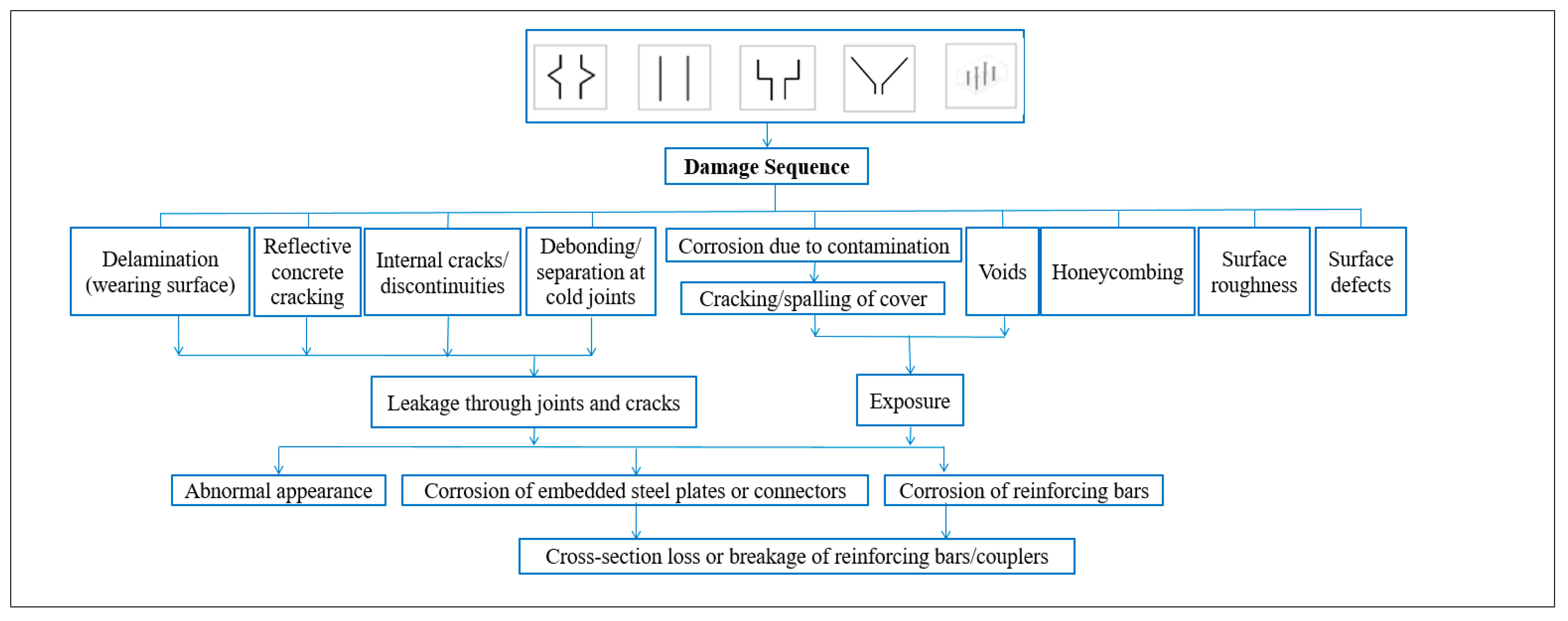
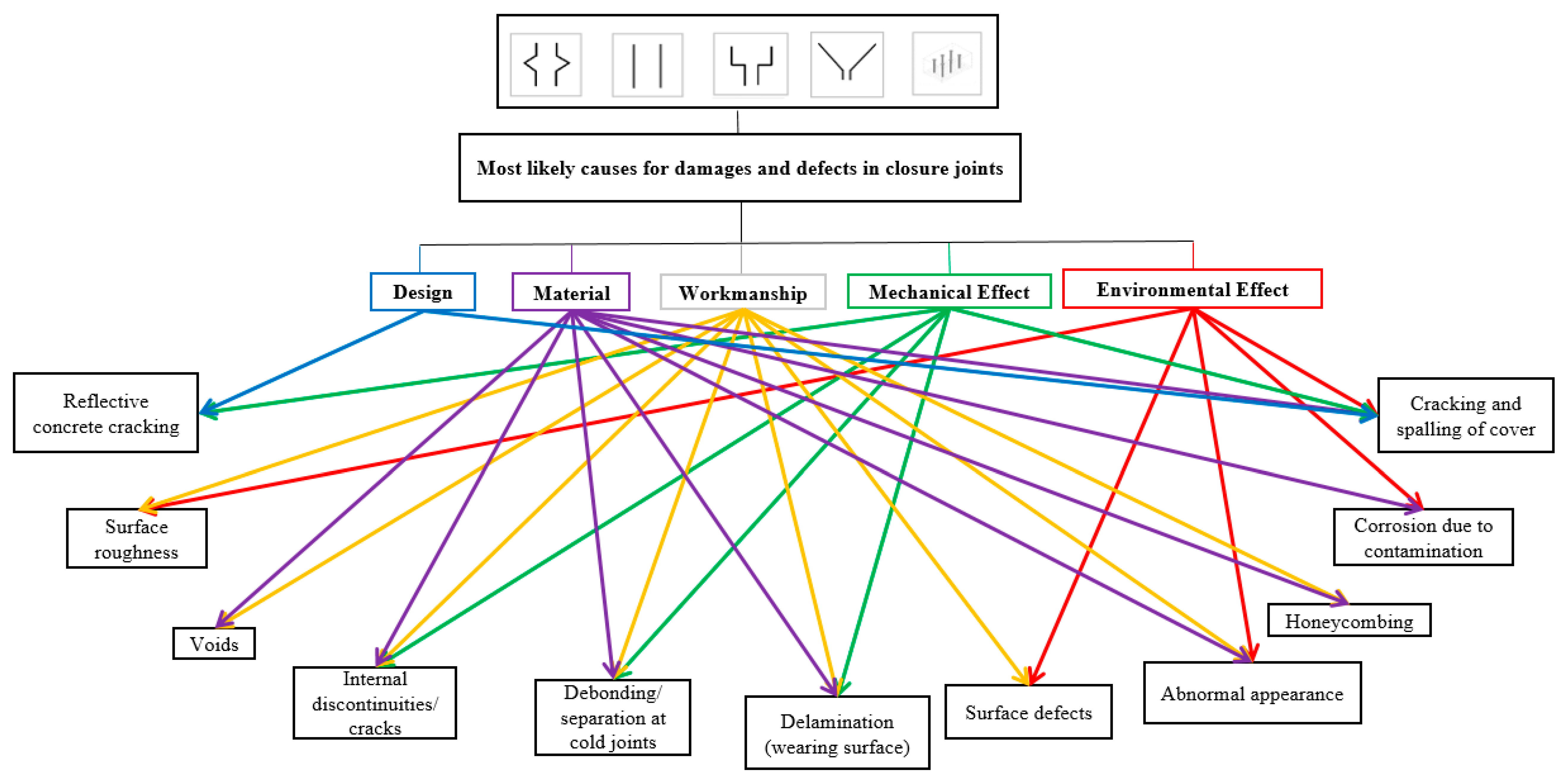
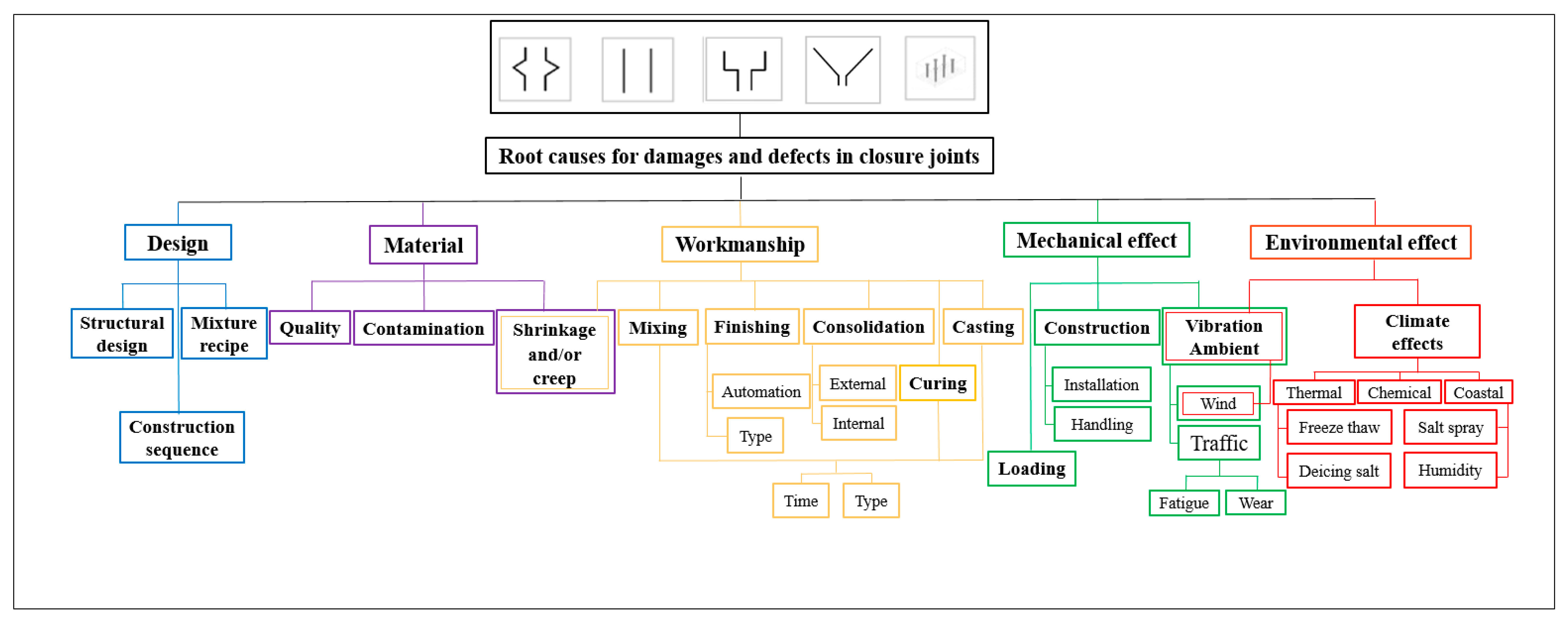
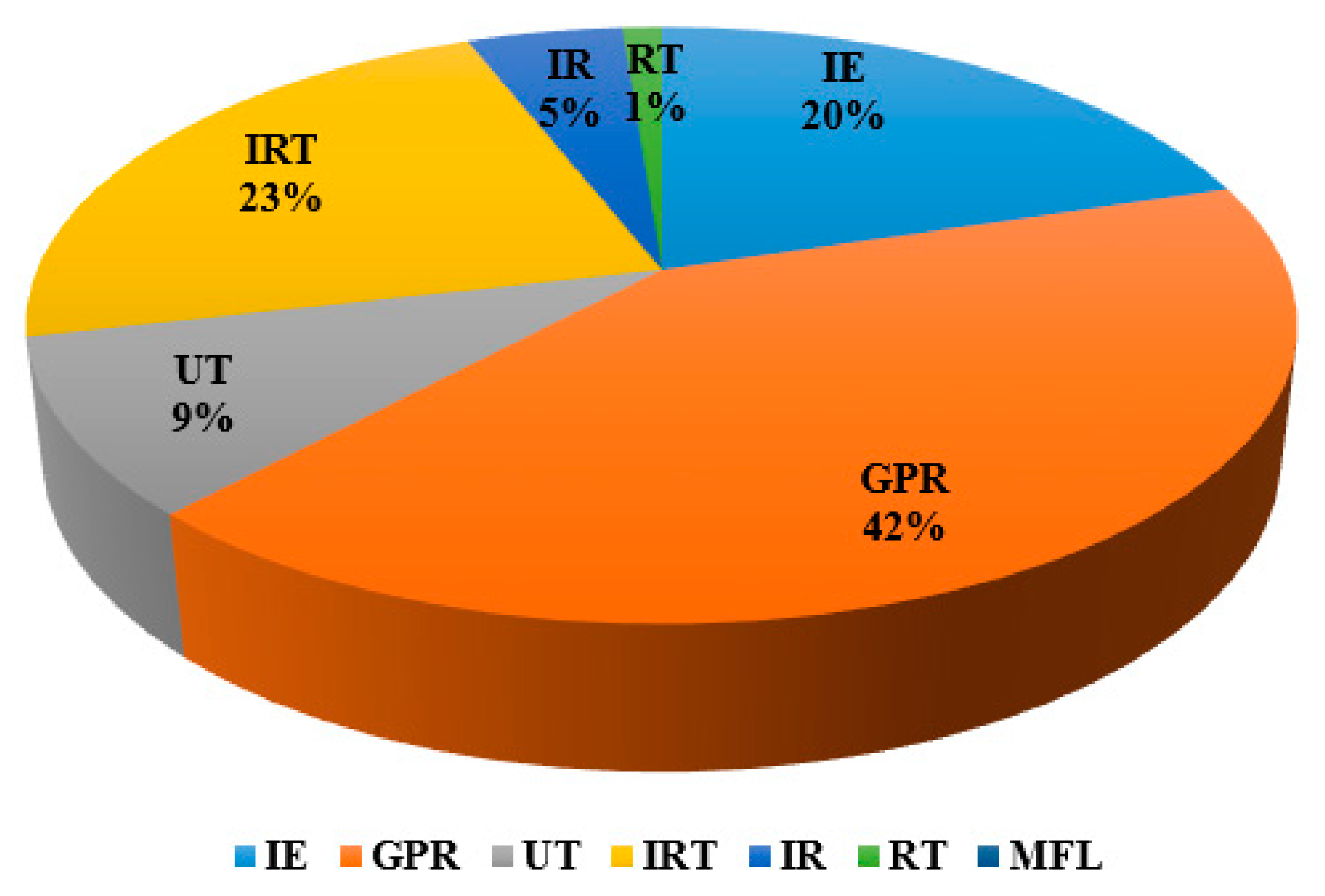
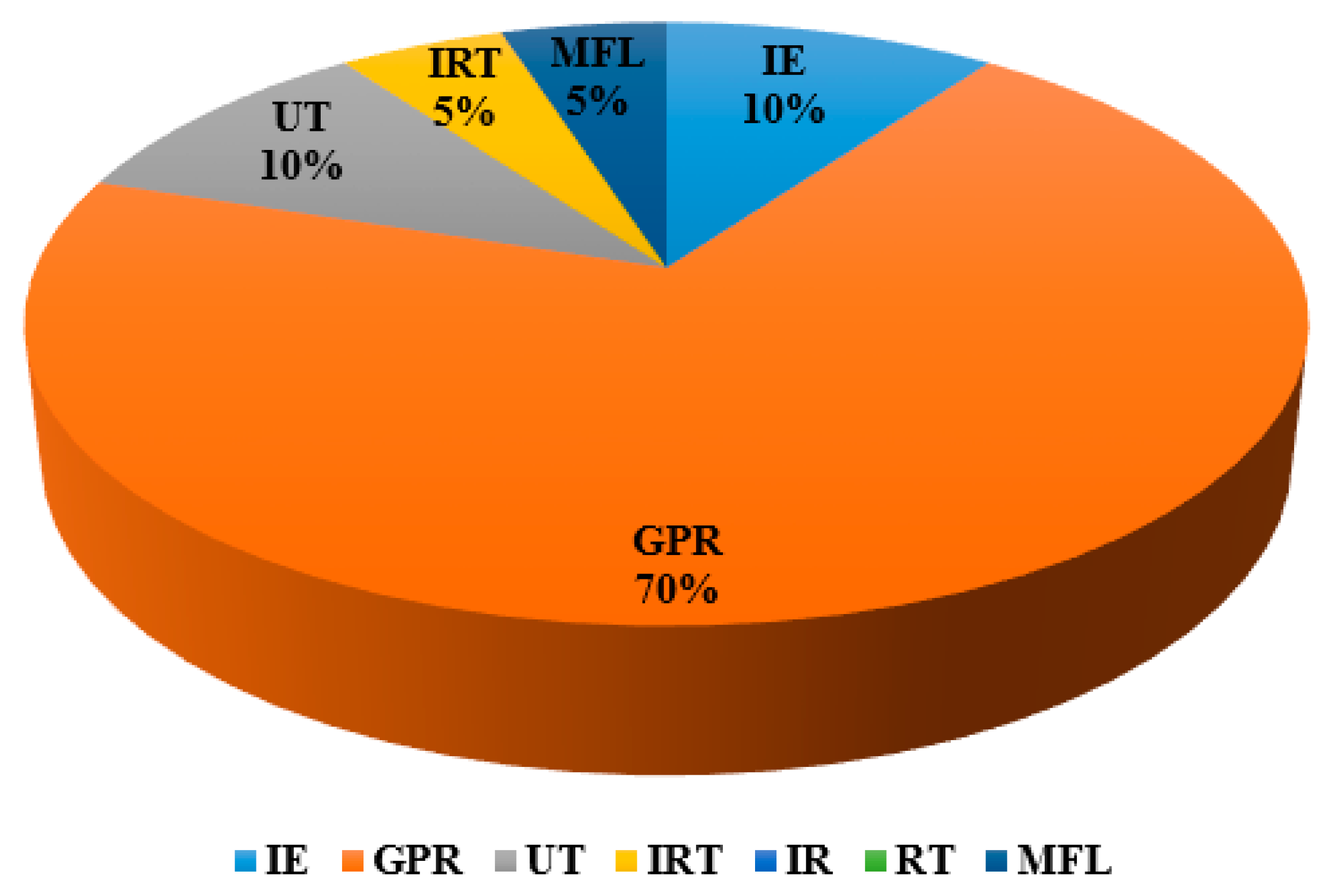
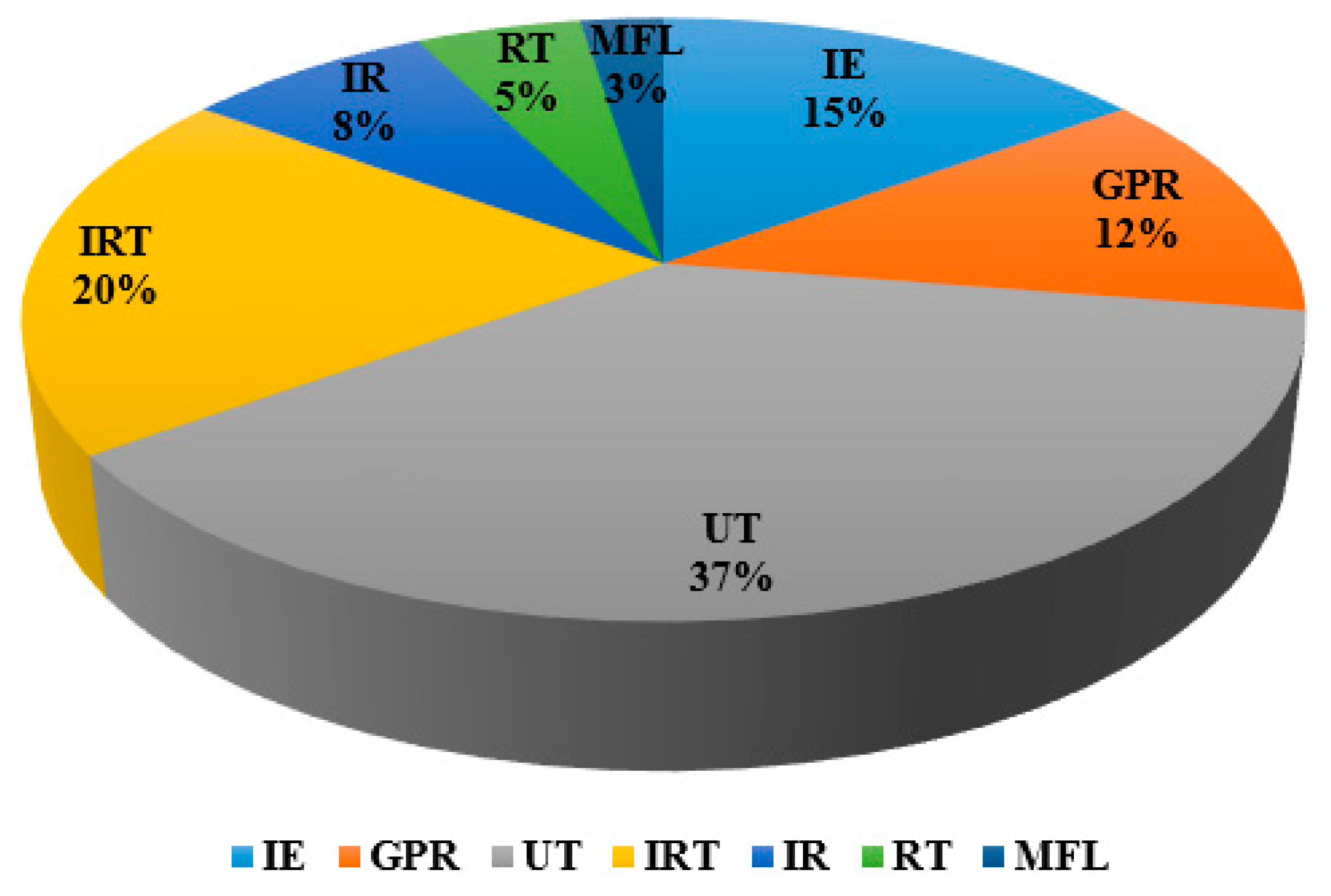
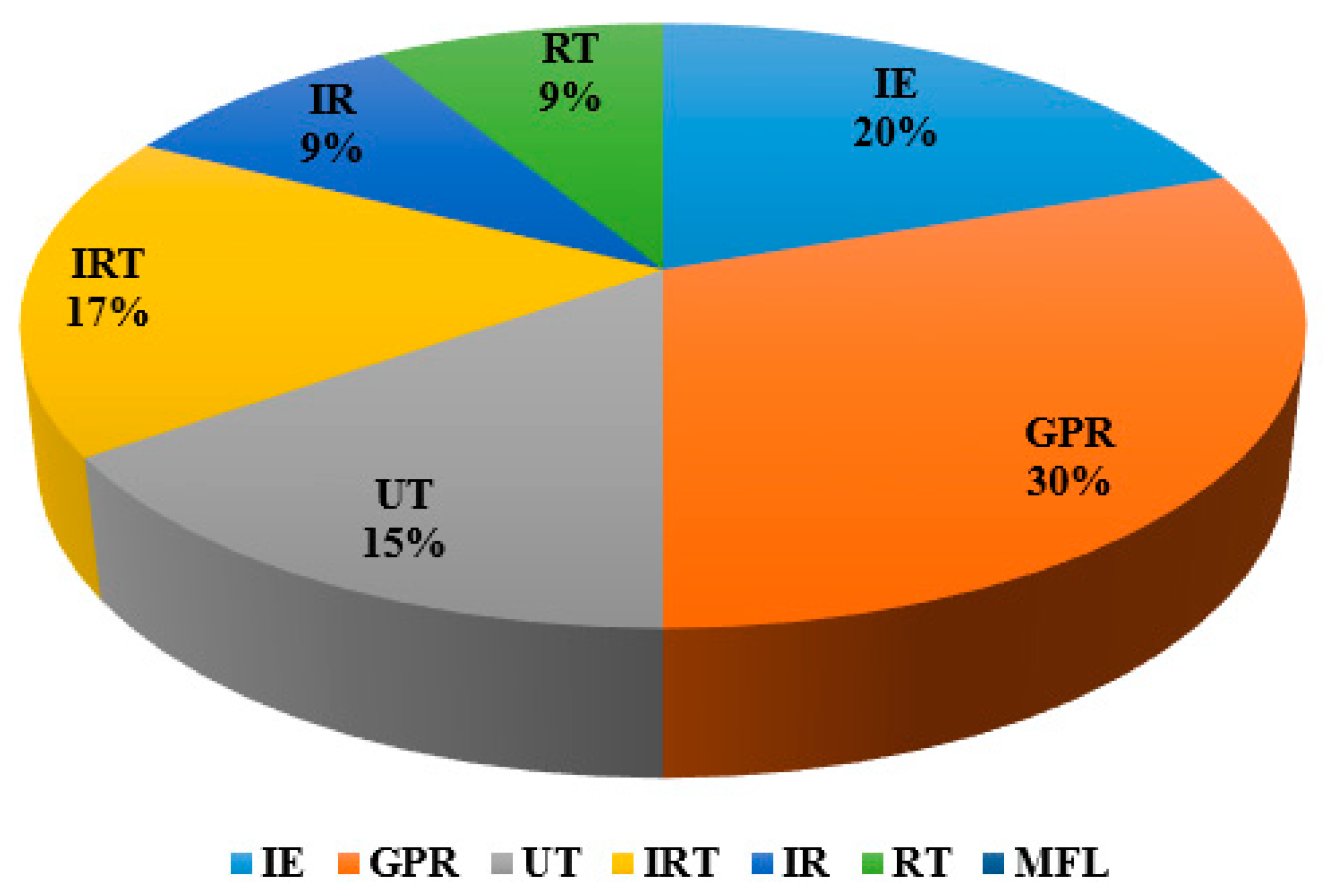
| Group | Brief Explanation | Symbol | A View and Cross-Section [1] |
|---|---|---|---|
| Type 1 | Usually for joining full-depth precast deck panels, generally have diamond-shape cavity for shear transfer. |  | 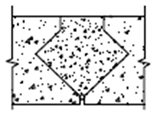 |
| Type 2 | Connecting full-depth precast deck panels to each other, and precast decks to precast concrete and steel girders. |  | 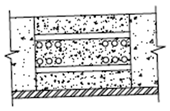 |
| Type 3 | Refers to linear joints that connect partial depth precast deck panels, butted decked precast girders, and in some cases, precast slab longitudinal connection to steel girders. |  |  |
| Type 4 | Has a V-shape cross section, used for connecting two prestressed T-beams, and sometimes full or partial depth deck panels. |  | 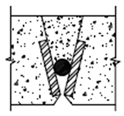 |
| Type 5 | Box-shaped joint, known as blockout, connects steel girders or concrete I-beams to precast full-depth deck panels. |  |  |
 ,
,  , and
, and  [1].
[1].
 ,
,  , and
, and  [1].
[1].| Capability | IE | GPR | UT | IR | IRT | RT | MFL |
|---|---|---|---|---|---|---|---|
| Test Speed |  |  |  |  |  |  |  |
| Internal Detection |  |  |  |  |  |  |  |
| Analyzing Speed |  |  |  |  |  |  |  |
| Cost |  |  |  |  |  |  |  |
| Accuracy |  |  |  |  |  |  |  |
| Ease of Use |  |  |  |  |  |  |  |
| Safety for Public and Operator |  |  |  |  |  |  |  |
| Required Operator Skill |  |  |  |  |  |  |  |
| Repeatability |  |  |  |  |  |  |  |
| Type of Defect | References | N | M | |
|---|---|---|---|---|
| Delamination | IE | [20,26,27,29,30,40,41,43,44,45,48,53,55,56,61,62,68] | 17 | 34% |
| GPR | [19,20,22,23,24,25,26,27,29,31,32,33,34,35,38,40,43,45,46,48,50,51,52,53,55,56,57,59,60,61,62,63,64,65,66] | 35 | 70% | |
| UT | [20,40,48,55,58,61,64,68] | 8 | 16% | |
| IR | [22,26,27,28,29,30,33,41,42,48,51,53,54,59,60,61,63,65,67] | 19 | 38% | |
| IRT | [21,40,48,51] | 4 | 8% | |
| RT | [32] | 1 | 2% | |
| MFL | --- | 0 | 0% | |
| Corrosion | IE | [26,56] | 2 | 4% |
| GPR | [19,20,24,26,27,31,34,37,38,44,45,48,55,62] | 14 | 28% | |
| UT | [47,56] | 2 | 4% | |
| IR | [27] | 1 | 2% | |
| IRT | --- | 0 | 0% | |
| RT | --- | 0 | 0% | |
| MFL | [28] | 1 | 2% | |
| Crack | IE | [27,29,47,48,55,61] | 6 | 12% |
| GPR | [19,34,35,52,55] | 5 | 10% | |
| UT | [20,23,26,28,32,36,39,40,48,53,55,58,60,61,64] | 15 | 30% | |
| IR | [20,28,29,47,48,61,65,67] | 8 | 16% | |
| IRT | [47,48,51] | 3 | 6% | |
| RT | [26,47] | 2 | 4% | |
| MFL | [49] | 1 | 2% | |
| Void | IE | [20,26,28,29,47,48,53,61,62] | 9 | 18% |
| GPR | [19,20,23,26,28,29,32,36,46,48,50,53,60,65] | 14 | 28% | |
| UT | [20,23,26,39,40,53,61] | 7 | 14% | |
| IR | [20,26,29,42,47,48,51,60] | 8 | 16% | |
| IRT | [21,47,48,51] | 4 | 8% | |
| RT | [26,32,47,53] | 4 | 8% | |
| MFL | --- | 0 | 0% |
© 2020 by the authors. Licensee MDPI, Basel, Switzerland. This article is an open access article distributed under the terms and conditions of the Creative Commons Attribution (CC BY) license (http://creativecommons.org/licenses/by/4.0/).
Share and Cite
Farhangdoust, S.; Mehrabi, A. Non-Destructive Evaluation of Closure Joints in Accelerated Bridge Construction using a Damage Etiology Approach. Appl. Sci. 2020, 10, 1457. https://doi.org/10.3390/app10041457
Farhangdoust S, Mehrabi A. Non-Destructive Evaluation of Closure Joints in Accelerated Bridge Construction using a Damage Etiology Approach. Applied Sciences. 2020; 10(4):1457. https://doi.org/10.3390/app10041457
Chicago/Turabian StyleFarhangdoust, Saman, and Armin Mehrabi. 2020. "Non-Destructive Evaluation of Closure Joints in Accelerated Bridge Construction using a Damage Etiology Approach" Applied Sciences 10, no. 4: 1457. https://doi.org/10.3390/app10041457
APA StyleFarhangdoust, S., & Mehrabi, A. (2020). Non-Destructive Evaluation of Closure Joints in Accelerated Bridge Construction using a Damage Etiology Approach. Applied Sciences, 10(4), 1457. https://doi.org/10.3390/app10041457






